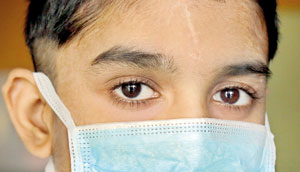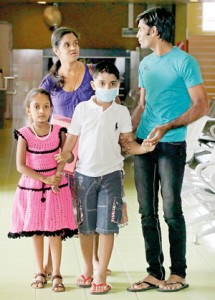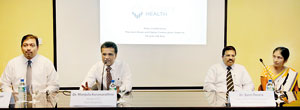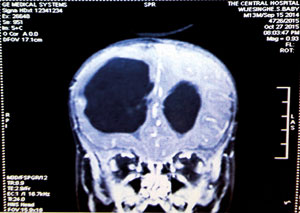News
Skill of hospital staff saves bright child’s life

Nethmini:'Miraculous' recovery
As he walks in shyly and hesitantly into the auditorium, clasping his Thaththa’s hand tightly and later into the cafeteria trailed by his Amma and his Nangi, he is the star attraction.
“Me Embilipitiye babane,” the staff murmur and gather around him and his family to ask after his health.
It was not that long ago that 10+ Sashith Kavindu Nethmina was brought all the way from his humble home in Udagala Gama, in Thunkama, Embilipitiya, by his desperate and distraught father, Sampath Nishantha Kumara, to be wheeled on a trolley into the room of Consultant Neurosurgeon Dr. Sunil Perera at the Asiri Central Hospital in Colombo 10.
And it is not only the expertise and skill of the team at the Asiri Brain & Spine Centre which have put Nethmina well on the way to recovery but also the fervent wishes and support of this private hospital’s management and other staff.
Bright-eyed Nethmina looks curiously around the auditorium at the cameras and crowd of journalists on Wednesday and slightly weary after some time gives a big yawn.
It is when we look closely that we see pointers to the major head trauma that he has suffered. Light scars are visible on his face and although his hair has now grown back thickly, markings indicate where head surgery has been performed to put his brain right, while when walking, there is a slight drag of his left foot.

A loving family: Sampath and Sunethra with Nethmina and Senithi. Pix by M.A. Pushpa Kumara
The event which in a matter of minutes cruelly changed the life of this clever 10-year-old studying at the Embilipitiya Janadhipathi Vidyalaya came in the wake of Nethmina scoring a ‘very high’ 188 marks out of 200, at the competitive Grade 5 Scholarship Examination last year. He had secured the 9th rank island-wide and was looking forward to a different chapter in his life in a Colombo school which would help him attain his goal of becoming a doctor.
The family was ecstatic and on October 21, last year, just a day after his 10th birthday which was on the 20th, he with his mother, Sunethra Kumari, accompanied by four teachers went by van for the Felicitation Ceremony held by the education authorities at the Sabaragamuwa Provincial Council office at Ratnapura.
Tragedy struck on the return trip home at Welimaluwa, eight kilometres from Ratnapura, when a bus collided head-on with the van, leaving Nethmina in his smart white shirt and blue shorts mangled and unconscious. The cherished certificates that he had on his lap lay blood-spattered.
Rushed to the Ratnapura Hospital, he was transferred to the National Hospital of Sri Lanka (NHSL) the same day. Recalling those terrible times, Sampath who struggles to keep the home fires burning by doing wiring weda (work), says that his son was unconscious for five days.
“Oluwa keduna, weeduru keli oluwa athule thibba,” he says, explaining that the skull was fractured and glass splinters were embedded in his brain. The NHSL doctors had treated Nethmina for a frontal skull fracture, foreign bodies in the brain and cerebrospinal fluid (CSF) leakage.
Eleven days after the accident, Nethmina regained consciousness and resumed talking and walking and was sent home, says Sampath.
By December 4, though, the boy was struck down by a very high fever and the parents rushed him to the Embilipitiya Hospital. Once again he lost consciousness and was transferred to the Karapitiya Teaching Hospital where he was diagnosed with meningitis (a germ in the brain) and subdural empyema, undergoing multiple operations. Subdural empyema is an abscess between the dura mater (the tough outermost membrane covering the brain) and the arachnoid mater (the middle membrane).

From left: Asiri Central Medical Director Dr. Harsha Baranage; Asiri Hospital Group’s Chief Executive Officer Dr. Manjula Karunaratne; Consultant Neurosurgeon Dr. Sunil Perera; and Consultant Anaesthetist Dr. Rohini Ranwala
“Sihiya thibbe ne, kalpanawa ne, as deka aragena hitiyata,” says Sampath, adding that though Nethmina would open his eyes, he did not respond. He was being fed through a peg tube inserted into his tummy.
They lost all hope, when Nethmina was sent home on February 17. But the teachers of his school and the parents of his classmates were not ready to give up and insisted that he should be shown to Dr. Perera. On February 19, they wheeled a supine boy before Dr. Perera, who promised that he would try to get Nethmina back on his feet. (See box please)
With the discussions revolving around money – for the procedure as well as the stay in the Intensive Care Unit and ward — which would easily amount to about Rs. 1.5 million, Nethmina’s best friend’s father, Ranjith Dissanayake, and Embilipitiya businessman, Ajith Thiththagalla, assured a helping hand.
This was while both the Neurosurgical Team headed by Dr. Perera and the Anaesthetic Team headed by Consultant Anaesthetist Dr. Rohini Ranwala waived their full fee; on the request of Dr. Perera the management of Asiri Central wrote off some major costs and the nurses in the neurosurgery ward donated to Nethmina the full year’s discount on medicine granted by the hospital to its staff.
Asiri Hospital Group’s Chief Executive Officer, Dr. Manjula Karunaratne, turns the spotlight on Asiri Central, the 260-bed flagship hospital of the group which has had many firsts to its credit. The Brain & Spine Centre which performs around 1,000 neurosurgeries each year has a dedicated 40-bed ward, a dedicated 11-bed ICU and three dedicated Operating Theatres.
This state-of-the-art centre has sophisticated equipment including neuro-navigation units and intra-operative monitoring, with intra-operative Computed Tomography (CT) scanning to be introduced by the end of this year.
Meanwhile, “miraculous”, is how Dr. Karunaratne describes the recovery of Nethmina, paying tribute to the efforts of the Brain & Spine Centre Team.

Excess CSF shunted from brain to abdomen  Nethmina’s brain imaging showing dark blobs of excessive cerebrospinal fluid He could not eat, speak or walk, with his eyes slightly open and was literally in a vegetative state. Magnetic Resonance Imaging (MRI) indicated that Nethmina’s brain was full of excess cerebrospinal fluid (CSF), causing severe hydrocephalus. Usually, CSF cushions the brain and protects it from injury inside the skull. It delivers nutrients and removes waste products, flowing through the ventricles to the base of the brain, bathing the brain and the spinal cord, before being re-absorbed into the blood. When Nethmina’s skull fractured, a large 7cm cyst full of CSF had formed in the right frontal region, causing heavy pressure and harming the brain in that area. There was also a build-up of excess CSF in the ventricles, explains Dr. Perera, pointing out that normally a child would have about 150ml (½ a tea-cup) of CSF in the ventricles while Nethmina had about a litre. The urgent need was a procedure known as ‘cyst penetration and insertion of a ventriculoperitoneal (VP) shunt’, he says, adding that they had to get into the cyst, decompress it and open it into the closest ventricle, making it one cavity. Thereafter, they had to insert a shunt to get the excess CSF into the abdomen from the brain, to relieve intracranial pressure. Sunday, February 21, Sampath remembers like yesterday – for that was the day when Nethmina was taken into the Operating Theatre (OT) for the brain surgery lasting nearly six hours. While the father paced up and down just outside the OT and the mother and seven-year-old daughter, Senithi Kavisha, offered flowers at the tiny shrine in their home to invoke blessings, Nethmina was put under general anaesthesia by Dr. Ranwala and her team. Dr. Perera and his team then began their delicate task. To get access to the brain, they performed a frontal craniotomy (removal of a skull bone flap). After opening out the cyst to the ventricle, the VP shunt was inserted, with the other end being sent subcutaneously (just under the skin) down to the chest and onto the abdomen. The shunt has a valve which is controlled by a sophisticated device, placed behind Nethmina’s ear. This device regulates the flow of CSF into the abdomen, depending on the build-up of pressure inside the skull. As Nethmina grows up it can be programmed to control the CSF flow into his abdomen at different stages of his life. This is done through an external remote control. Smilingly conceding that this brain surgery is nothing new and he has done hundreds of them, Dr. Perera reiterates that what is important is to identify the exact problem and attend to it with the right neurological procedure. It is also vital to attend to children’s brain injuries urgently as brain growth doubles in the first two years of life and up to 12 years of age grows by 15% each year. “Five days after the surgery, Nethmina was eating and two months later he was talking and recalling past events and also walking,” says Sampath. This boy who was taken to hospital flat on a trolley was home in just a month, by March 21. He is now undergoing physiotherapy and speech therapy and taking medicines to prevent seizures (fits). A silver lining is appearing for this family amidst the stormy clouds that have been buffeting them since that fateful day in October. “Soon, may be in about six months, he will be able to get back to his books and studies,” says Sampath with emotion, as a wisp of a smile wreathes his trembling lips. Whispering a blessing on the doctors and all those who helped him to get his beloved son back on his feet, he adds: “Dr. Sunil Perera gave my son life. We have immense faith that as the doctor promised, very soon Nethmina will return to school.”
|

